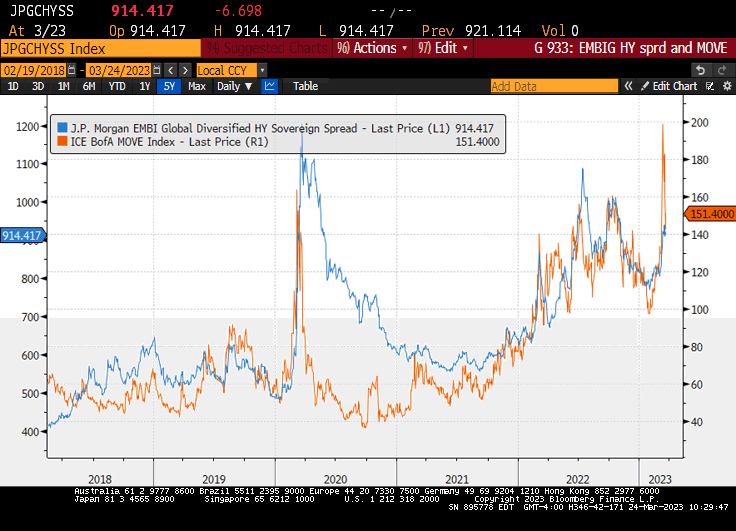EM – Prepared For More Turmoil?
24 March 2023
Read Time 2 MIN
Market Expectations for The Fed
Concerns about “dry wood” in developed markets (DM) banks refuse to go away, driving recession fears up and market expectations for the U.S. Federal Reserve (Fed) policy rate down. However, while short rates are dropping like a stone, very long rates are still range-bound – an indication that perceived inflation risks are yet to decline. The consensus outlook for emerging markets (EM) inflation is also cautious in the sense that inflation can realistically return to target already this year only in one region – EM Asia (we should also mention Brazil and South Africa here, but these are exceptions in their respective regions). Still, the timely policy response earlier in this cycle means that EM real policy rates adjusted for expected inflation are much higher than in DM, providing a safety cushion when things get tough. Another differentiator this time around is EMs’ stronger correlation with China, which is clearly on the rebound and set to grow much faster this year than any DM.
EM Rate Cut Prospects
High real policy rates notwithstanding, EM central banks are not in a rush to cut. The top domestic reasons include uncertainty about the pace of disinflation and concerns that inflation expectations could remain unanchored if central banks move prematurely. Brazil’s disinflation progress has been spectacular – today’s mid-month prints showed further moderation to 5.36% year-on-year – but waves of political and policy noise keep the central bank on its toes. The presentation of the new fiscal framework was delayed, and President Luiz Inácio Lula da Silva’s (Lula’s) renewed attacks on the central bank forced the market to re-adjust expectations for near-term rate cut prospects (as well as preventing the Brazilian real from participating in the post-Fed EM FX rally).
EM Bonds and Market Volatility
Of course, EM is not a monolith – EM Graduates might be in a better position to deal with market turbulence, and many EM currencies behaved as safer havens during the previous (banking mini-crisis) episode. However, frontier markets are definitely more exposed. Spreads on lower-rated sovereign bonds show strong correlation with global interest rates’ volatility (see chart below), and this particular factor was behind EM High Yield sovereign bonds’ month-to-date underperformance despite a big rally in the treasury portion of their total return. Stay tuned!
Chart at a Glance: EM High Yield Bonds – DM Rates Volatility Is A Major Risk Factor

Source: Bloomberg LP.
The J.P. Morgan EMBI Global Diversified HY Sovereign Spread Index is a subset of the J.P. Morgan Emerging Market Bond Index Global Diversified (EMBIGD), which is an unmanaged, market-capitalization weighted, total-return index tracking the traded market for U.S.-dollar-denominated Brady bonds, Eurobonds, traded loans, and local market debt instruments issued by sovereign and quasi-sovereign entities.
The ICE BofA MOVE Index tracks fixed income market volatility.
Related Insights
IMPORTANT DEFINITIONS & DISCLOSURES
This material may only be used outside of the United States.
This is not an offer to buy or sell, or a recommendation of any offer to buy or sell any of the securities mentioned herein. Fund holdings will vary. For a complete list of holdings in VanEck Mutual Funds and VanEck ETFs, please visit our website at www.vaneck.com.
The information presented does not involve the rendering of personalized investment, financial, legal, or tax advice. Certain statements contained herein may constitute projections, forecasts and other forward looking statements, which do not reflect actual results. Information provided by third-party sources are believed to be reliable and have not been independently verified for accuracy or completeness and cannot be guaranteed. Any opinions, projections, forecasts, and forward-looking statements presented herein are valid as of the date of this communication and are subject to change without notice. The information herein represents the opinion of the author(s), but not necessarily those of VanEck.
The views contained herein are not to be taken as advice or a recommendation to buy or sell any investment in any jurisdiction, nor is it a commitment from Van Eck Associates Corporation or its subsidiaries to participate in any transactions in any companies mentioned herein. This content is published in the United States. Investors are subject to securities and tax regulations within their applicable jurisdictions that are not addressed herein.
All investing is subject to risk, including the possible loss of the money you invest. As with any investment strategy, there is no guarantee that investment objectives will be met and investors may lose money. Diversification does not ensure a profit or protect against a loss in a declining market. Past performance is no guarantee of future results.
